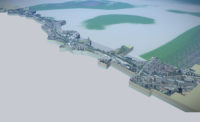In Afghanistan's Bamyan Province, a New Zealand-funded development project is now bringing 24-hour electricity to 2,490 homes and businesses in scattered hamlets with an off-the-grid, 1.05-MW network of solar arrays, batteries, backup generators and transmission lines.
The $14.2-million project includes five arrays, mostly perched on rough hillsides about 10 km apart at an elevation of 8,500 ft. It now is in the hands of the Afghan national electricity utility for a 24-month, post-construction run-in maintenance period.
The developer is the Bamyan Renewable Energy Programme Partnership. Program manager is International Strategic Development Solutions, a New Zealand company specializing in program management for development and reconstruction in challenging environments.
ISDS was launched in 2010 by two long-serving veterans of New Zealand's reconstruction in Afghanistan, Karl Maddaford and Alpha Kennedy. They founded ISDS on a philosophy that reconstruction success in unstable, conflict or post-conflict zones requires deep community engagement and capacity-building focused on direct local input in construction as well as in post-construction management, operations and maintenance.
"We very deliberately are not a technical-based entity," says Maddaford, CEO. "We are not road builders, vertical constructors, renewable energy implementers or agronomists—even though we have successfully delivered programs in each of these disciplines. We are reconstruction program specialists."
The utility's equipment must meet standards for a 20-year service life in an environment that includes 100-km-per-hour continuous winds, with gusts to 150 km per hour, as well as heavy snow, deep cold and continuous dust. The project includes build-out of storage battery banks, back-up generators, transmission lines as well as distribution, metering, maintenance and management systems. All components must be available in-country, supportable by Afghan resources and maintainable by local staff.
One of the tools ISDS uses in the project is a service from San Diego-based NoteVault, a voice-to-text mobile reporting system for contractors. It stores verbal notes on a smartphone and uploads them for transcription and routing whenever cell coverage is found. Seeing "a real utility in NoteVault for this and all future projects," Maddaford says he deployed it to capture progress notes and photos from a team spread out in a mountainous region, where Internet and mobile coverage is intermittent and unreliable.
"By combining advanced tools such as NoteVault, [we] were able to maintain a higher degree of control over project variables and progress," Maddaford says. Issues are raised and addressed quickly while maintaining "a high level of inclusion" to stakeholders—most of whom were not in Afghanistan.
"The project has been very favorably received by the local community as this is the first time they have had access to mains power," Maddaford says. "Primary recipients have been residential households—allowing opportunities to study after dark and significantly increasing the standard of living."





